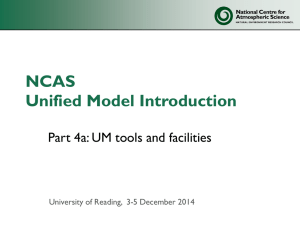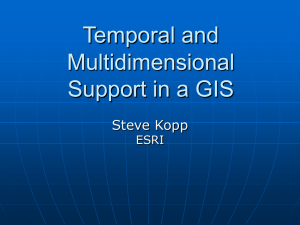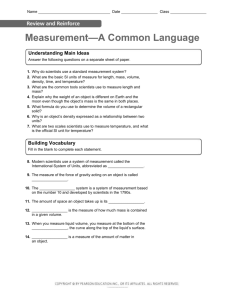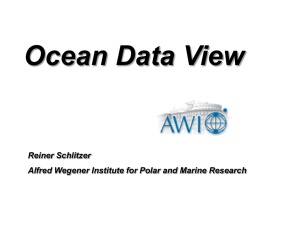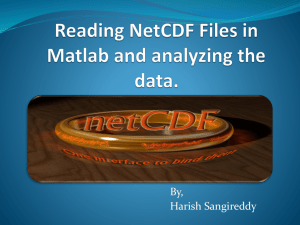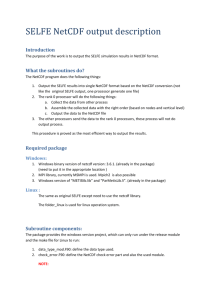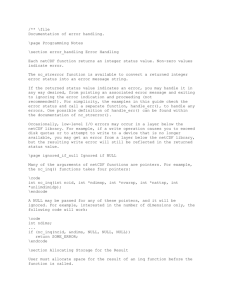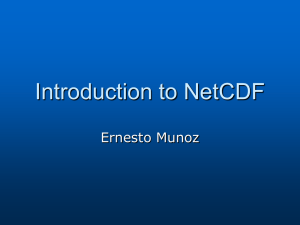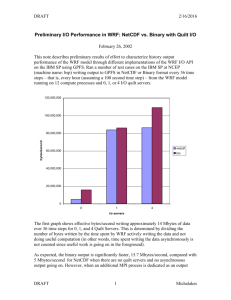JasonWoodring_su14 - University of Washington
advertisement
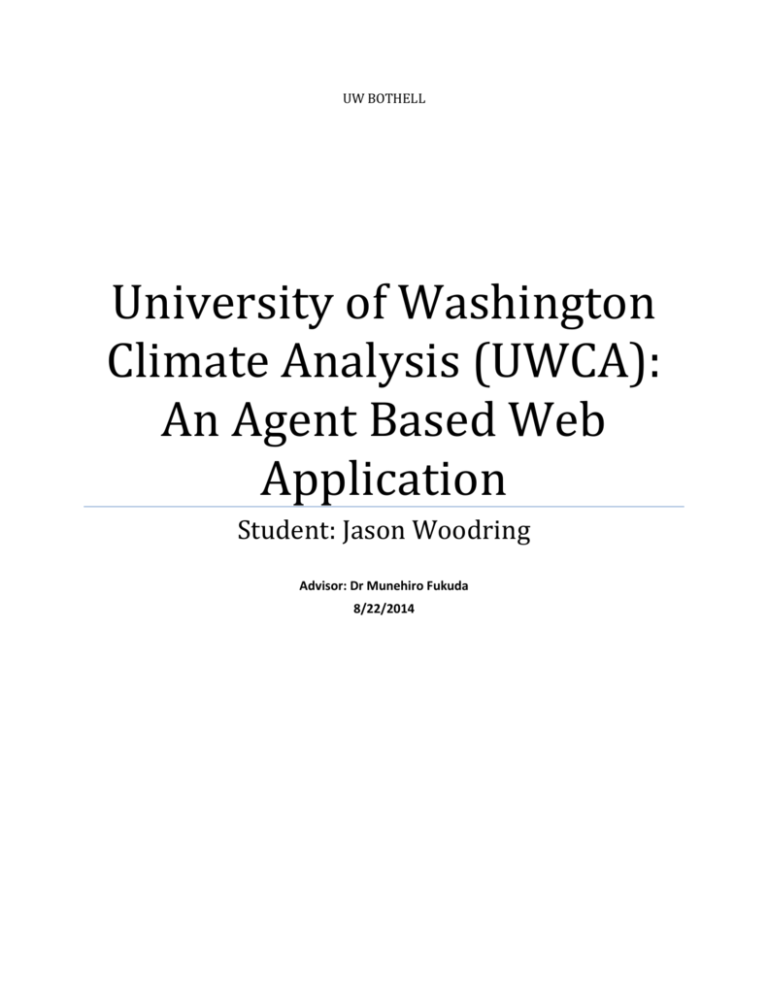
UW BOTHELL University of Washington Climate Analysis (UWCA): An Agent Based Web Application Student: Jason Woodring Advisor: Dr Munehiro Fukuda 8/22/2014 Contents Team Members .......................................................................................................................... 1 Activity Grid ................................................................................................................................ 1 Architecture................................................................................................................................ 1 Architecture Feedback ............................................................................................................ 2 Architecture Diagram (Hardware View) ................................................................................... 2 Architecture Diagram (Process View) ..................................................................................... 3 Integrated Summary of Literature Reviews ................................................................................ 4 Literature Bibliography ............................................................................................................... 5 Summary-to-date of your project status reports.......................................................................... 6 PowerPoint Feedback ................................................................................................................ 6 Appendices / Additional Documentation ..................................................................................... 6 Team Members None Activity Grid Please see appending documents for Project File Architecture Architecture Diagram (Pre Feedback) 1 Architecture Feedback Architecture Diagram (Hardware View) 2 Architecture Diagram (Process View) 3 Integrated Summary of Literature Reviews Climate scientists agree that climate is changing across the globe at an alarming rate. When sunlight travels through the atmosphere towards earth, some if it reflects back into space. However Co2 causes some of the sunlight to get trapped in the atmosphere. Because Co2 is increasing in the atmosphere, temperatures globally are increasing. Climate scientists believe that there is a >95% chance that human activities, specifically greenhouse gas emissions, aerosols, and land surface changes have exerted a substantial net warming influence on climate since 1750. They also believe that that there is a >90% chance that human greenhouse gas increases caused most of the observed increase in global temperature since the mid-20th century. Skeptics claim that there has been severe climate change in the earth’s history so what is happening now is natural. However what is truly alarming is the rapid rate of change, and the correlation to human industrialization / greenhouse emissions. The climate change that the earth is experiencing could have drastic impacts. As temperature rises, many different phenomenons may be experienced. Precipitation in the mountains in the wet season which would normally freeze will not, and that will result in several problems. First off , there will be increased flooding because the moisture is not being caught in the mountains. This will also generate extra power in the winter because of increased stream flows, but droughts and less power in the hot season due to less snowpack melt. Agriculture will be affected also, the Columbia river basin relies on the snowpack melt in the warmer months to irrigate crops. In an effort to understand and warn humanity, climate scientists have taken measure to predict the future state of the earth’s climate. Several different climate models are produced by climate science facilities in the form of common data sets such as NetCDF files which contain grid like data suitable for analysis. NetCDF has several different software packages available for working with NetCDF data from different software environments such as C++, Java, etc. A calculation of interest for climate scientists is Time of Emergence (ToE). Time of Emergence is the time at which certain climate properties become apparent. In other words, when a certain climate attribute such as temperature starts consistently rising above a certain threshold, then that could be considered the Time of Emergence for that property. ToE is important to predict, because that is the perceived indicator that could be a warning that extreme weather events could be increasing in frequency, such as storms or floods. There are challenges with analyzing this data however. The amount if data is large (can be in the Terabytes), and special computing hardware and advanced computer science concepts may be necessary to process and analyze the data. While large climate science facilities may have special computing setups to perform these analyses, many climate researchers are without these resources. For the climate scientists without the computing resources, they tend to rely on custom software to do their analysis. This presents a problem for climate scientists, they are usually not versed in advanced computer science concepts, so they may create scripts / programs which are unmaintainable, have poor performance, not distributable, or simply not working. 4 Literature Bibliography [1] Fukuda, M., Stiber, M., Salathe, E., & Kim, W. (2013). CDS&E: Small: Multi-Agent- Based Parallelization of Scientific Data Analysis and Simulation. [2] Michalakes, J., Dudhia, J., Henderson, T., Klemp, J., Skamarock, W., & Wang, W. (n.d.). The Weather Research and Forecast Model: Software Architecture and Performance. [3] Fukuda, M. (2010). MASS: Parallel-Computing Library for Multi-Agent Spatial Simulation. [4] Yasutake, B., Simonson, N., Asuncion, H., Fukuda, M., & Salathe, E. (2014). Supporting Provenance in Climate Research. [5] Zender, C., & Mangalam, H. (2007). Scaling Properties of Common Statistical Operators for Gridded Datasets. International Journal of High Performance Computing Applications,21. [6] Dalton, M., Mote, P., & Snover, A. (2013). Climate Change In The Northwest Implications for our Landscapes, Waters, and Communities. Island Press. [7] Salathe, E., Hamlet, A., & Mass, C. (2014). Estimates of 21st Century Flood Risks in the Pacific Northwest. [8] Climate Change Impacts and Adaptation in Washington State. (2013). Climate Impacts Group University of Washington. [9] Climate Change. (2014, January 1). Retrieved July 11, 2014, from http://cses.washington.edu/cig/pnwc/cc.shtml [10] NetCDF FAQ. (n.d.). Retrieved July 12, 2014, from www.unidata.ucar.edu/software/netcdf/docs/faq.html [11] Software for Manipulating or Displaying NetCDF Data. (n.d.). Retrieved July 13, 2014, from www.unidata.ucar.edu/software/netcdf/software.html [12] Muir, L., Brown, J., Risbey, J., & Wijffels, S. (n.d.). Determining the time of emergence of the climate change signal at regional scales. The Center for Australian Weather and Climate Research, Hobart, Australia. [13] Hawkins, E., & Sutton, R. (2012). Time of emergence of climate signals. American Geophysical Union. [14] Keller, K., Joos, F., & Raible, C. (2014). Time of emergence of trends in the ocean biogeochemistry. [15] Time of Emergence of Climate Change Signals in the Puget Sound Basin Quality Assurance Project Plan. (2013). Climate Impacts Group University of Washington. [16] Mahlstein, I., Knutti, R., Solomon, S., & Portmann, R. (2011). Early onset of significant local warming in low latitude countries. [17] Maraun, D. (2013). When will trends in European mean and heavy daily precipitation emerge? 5 [18] Ho, C., Hawkins, E., & Shaffrey, L. (2012). Statistical decadal predictions for sea surface temperatures: A benchmark for dynamical GCM predictions. [19] Capalbo, S., Eigenbrode, S., Glick, P., Littell, J., Raymondi, R., & Reeder, S. (2014). NORTHWEST. In Climate Change Impacts in the United States. Summary-to-date of your project status reports I am through requirements gathering for the most part. I’ve met with my stakeholders about six times now, and I have figured out with some degree of accuracy what they want to have. The big focus is on ToE and management variables which can be calculated with different parameters. They wish to have this application hosted in a web interface so it can be highly accessible. I have learned much from the literature reviews also. The reading has not only educated me but also peaked my interest in the subject. I have begun setting up my project and coding. I am ready to begin implementing my architecture and prototyping my analysis modules. I already have the front end created. I’ve been educating myself too on things like Maven, and Unit testing so I can apply these software libraries to my project in an effort to make it more tested, and maintainable. PowerPoint Feedback Appendices / Additional Documentation Below is a list of documents I have turned in with this master document. Diagrams.vsdx – My visio documents PNCA_Project_14aug14.mpp – My project plan UWCA.pptx – My final presentation woodring_literature_reviews.docx UWCA_SRS.docx – My software requirement specification PeerReview-Jason.pdf – The only peer review that was done for my architecture / ppt 6
